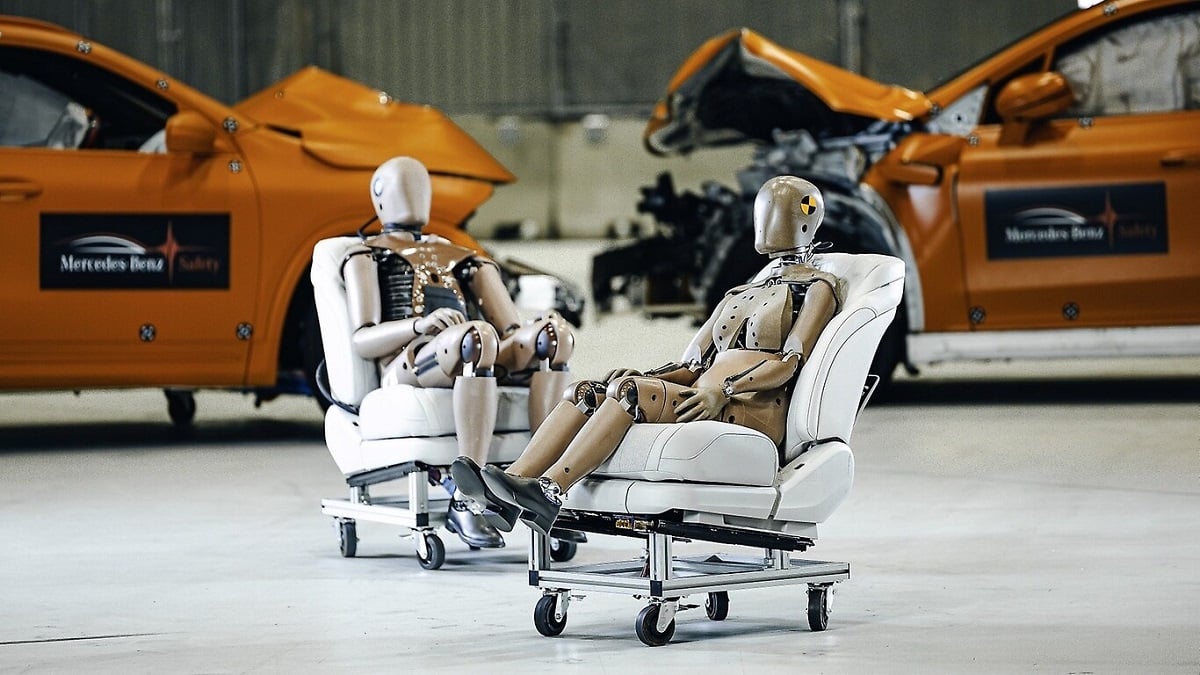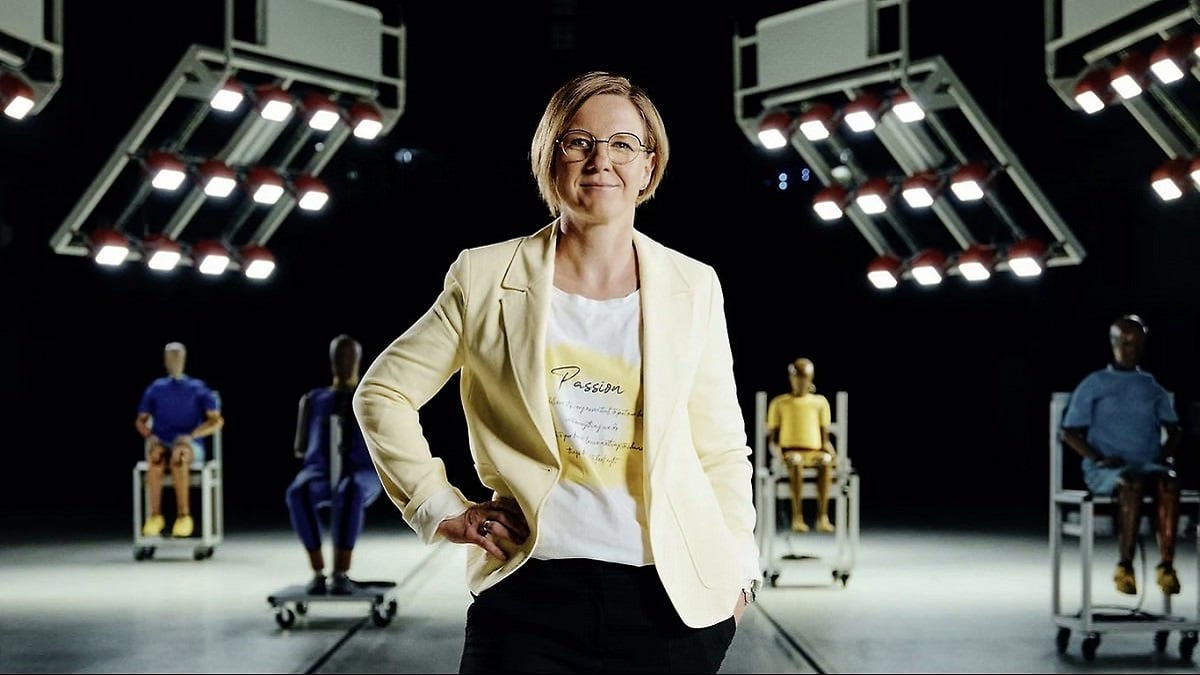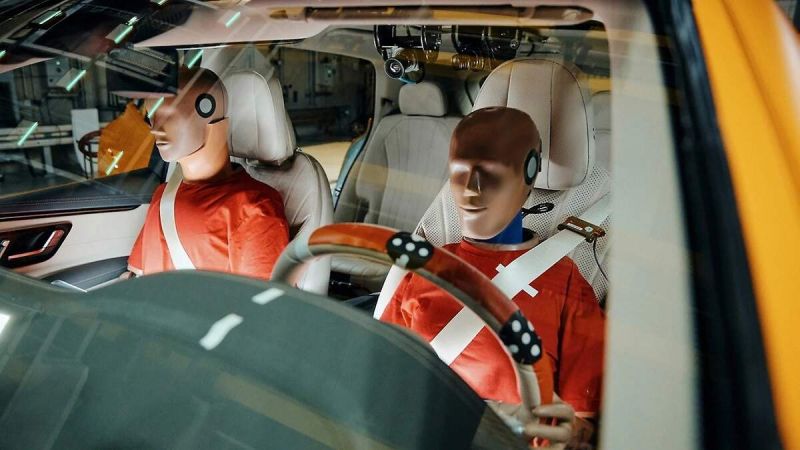The modern dummy has many sensors on various body parts, with more than 150 measuring points. She is around 1.5 meters tall and weighs 49 kilograms. The "fifth percentile female" has been a driver, front and rear passenger in the Mercedes-Benz frontal crash tests, for the last 20 years. It is always equal to the traditional male dummy - the Hybrid III 50. So the Germans have been using female dummies even before it was required by law.
The model resembles the female anthropometry with female breasts and pelvic bones and according to the statistics, only five percent of American women are smaller or lighter. These days ratings from consumer protection associations and various laws around the world include specifications for testing with fifth percentile female dummies.
Another type of dummy that Mercedes-Benz has used in crash tests for two decades is the SID-II female dummy. With an anatomy similar to that of the Hybrid III 5, SID - II has been designed specifically for side impact tests. However, its use in Europe is not yet required by law, unlike the USA.
120 dummies in 21 different versions undergo up to 900 crash tests each year
One of Benz's DNA core components is safety. The company is considered as the inventor of today's car safety - and remains a pioneer in the field.

Moreover, the people from Stuttgart have an in-house accident research center that has been investigating accidents involving Mercedes vehicles. This only shows the levels of the company's commitment to their client. The goal is to find out which advanced safety system could have prevented certain accidents, based on how those events happened.
What’s more, findings from real-life accidents can be used to define requirements for crash tests. The Mercedes-Benz Technology Centre for Vehicle Safety in Sindelfingen conducts up to 900 crash tests and 1,700 sled tests every year. The tests involve 120 dummies in 21 different versions – from toddlers, children of all ages, and fifth-percentile female dummies to 50th percentile male dummies and large, heavy male dummies[2].
After that - the results of the crash tests and accident research are used to help develop new safety technologies and improve existing systems. The topic of female dummies is currently the subject of much public debate. Hanna Paul, Head of Dummy Testing at Mercedes-Benz, fact-checks six of the most common myths.

Myth 1: Cars don’t protect women as well as they do men
Hanna Paul: No, that’s not true. First of all, here are two general findings from our accident database: In the case of severe or fatal injuries, there are no discernible relevant disparities between the sexes. Only in the case of minor injuries, there are certain disparities in individual cases.
Women are more susceptible to injury in some regions of the body (legs/feet and whiplash in a rear impact), while men may be more severely affected in others (head, chest). In addition, analysis carried out by our accident research team has revealed that there are no anomalies with regard to women or men in Mercedes-Benz vehicles. This shows that the safety design of Mercedes-Benz vehicles is effective in real-life accidents. This underscores our ambition of ‘real-life safety’.
Myth 2: Statistics are showing that women are less protected
Hanna Paul: Again, a resounding no. The accident figures cited in these statistics often date back to the 1980s. A great deal has happened since then in terms of passive vehicle safety. Passenger cells, even in small vehicles, have become much more stable. At the same time, modern restraint systems are now used in all vehicle classes. Belt force limiters, for example, which limit the pressure on the chest, adapt to the requirements of the occupants with a defined force curve.
However, another aspect of these often-cited studies still applies today. Namely, in terms of global statistics, women often drive older, smaller cars. This is confirmed by a study carried out by the American insurance organization Insurance Institute for Highway Safety. (IIHS). But, as I already mentioned, the safety level has improved significantly in all vehicle segments, including in small cars. This led the US National Highway Traffic Safety Administration (NHTSA) to determine that the disparities in fatality rates between men and women fell significantly starting with model year 2000 vehicles.
Myth 3: Male dummies are predominantly used in crash tests
Hanna Paul: Not at Mercedes-Benz. We have been using female frontal impact dummies and female side impact dummies in our crash tests for more than 20 years. But dummies are not human dolls. They are instruments that measure physical forces and trajectories. Their weight and size are derived from real-life human data. Female dummies correspond to, or are scaled to, the female anatomy. However – and this is decisive – the forces acting on dummies during crash tests are converted into injury risks. These risks are calculated based on injury data for both men and women. The common limits for female dummies are lower than for male dummies for the same injury risk. This means that the dummies do a good job of representing injury risks for the unique anatomical characteristics of men and women. The size and weight of the types of dummies used at Mercedes-Benz are gender-specific. The fifth percentile dummy[3] has female anatomy, but in terms of injury risk, it represents small people in general – regardless of whether they are men or women. In other words, injury risks are human, not male or female. The same applies to the other dummies as well: The 50th percentile male[4] mimics the male anatomy, but it also represents the injury risks that an average woman faces. The NHTSA is currently investigating the extent to which injury risks vary by gender. The first published results confirm our findings that gender is not the most important factor influencing injury frequency. The dummies we use today are therefore effective measuring tools for developing safety systems.
Myth 4: Crash test dummies are not diverse enough
Hanna Paul: In recent years, the number of dummy types has increased significantly, partly due to the many different types of collision that are being tested. Mercedes-Benz has a total of over 120 dummies. They come in various sizes and weights – from babies weighing only 3.5 kilos and children and teenagers of various ages to fifth-percentile females and heavy dummies. There are also different types of frontal, rear, and side impacts. Which dummies are used in each type of crash test is defined in the test specifications set out in laws, ratings, and specific Mercedes-Benz load cases. Dummies are regulated in detail to ensure worldwide comparability. Even their clothing is regulated. Dummy technology is currently undergoing a generational change. The advanced THOR dummy is replacing the Hybrid III dummy introduced in 1986. THOR dummies are more biofield, i.e. they more accurately depict the human body and offer extended measurement options. According to our internal research, a further expansion of dummy types would not bring any significant improvement in safety.
Myth 5: Pregnant women are less protected
Hanna Paul: A comparison of systems in a recent study by ADAC (Allgemeiner Deutscher Automobil-Club, transl. ‘General German Automobile Club’) shows that normal seat belts protect both expectant mothers and their unborn children well in the event of an accident. According to accident research by ADAC, pregnant women are no more at risk than other drivers. When used properly, normal three-point seat belts protect both pregnant women and their unborn children in the event of an accident.
Myth 6: Simulations will soon replace physical crash testing
Hanna Paul: We don’t see that happening. Indeed, calculating kinematics and deformation can significantly reduce the number of whole-vehicle tests and speed up development at the same time. However, there are several reasons why there is no way around vehicle crash testing: On the one hand, crash tests are necessary to validate simulations, which are based on many assumptions. On the other hand, they are required by law or ratings. In whole-vehicle tests, sensors can be used to get the best picture of how a crash develops and how the dummies behave during it.
Occupant simulations merely calculate how a dummy would behave in a vehicle. Mercedes-Benz is also working on so-called human body models (HBMs), which are designed to represent human anatomy – bones, muscles, and organs – in even greater detail. Compared to dummies, using HBMs in crash tests allows researchers to assess the actual type of injury that a particular part of the body is likely to suffer, rather than simply calculating the probability of injury severity. We use HBMs, among other uses, to evaluate our innovative restraint systems such as PRE-SAFE® Impulse Side. Benz uses the most advanced dummies during the tests of their latest models.
PHOTOS: Mercedes-Benz
Boris Georgiev has been a journalist for over a decade now, but for the last few years, he decided on cars and motorsport. He has been attending different events and car shows, expanding his knowledge and automotive expertise. Having driven various Mercedes-Benz models throughout his life, he naturally finds himself attracted to the brand. Boris is now a true Benz expert and reports the latest stories about the company. Please follow him on X for more Mercedes-Benz tweets.












